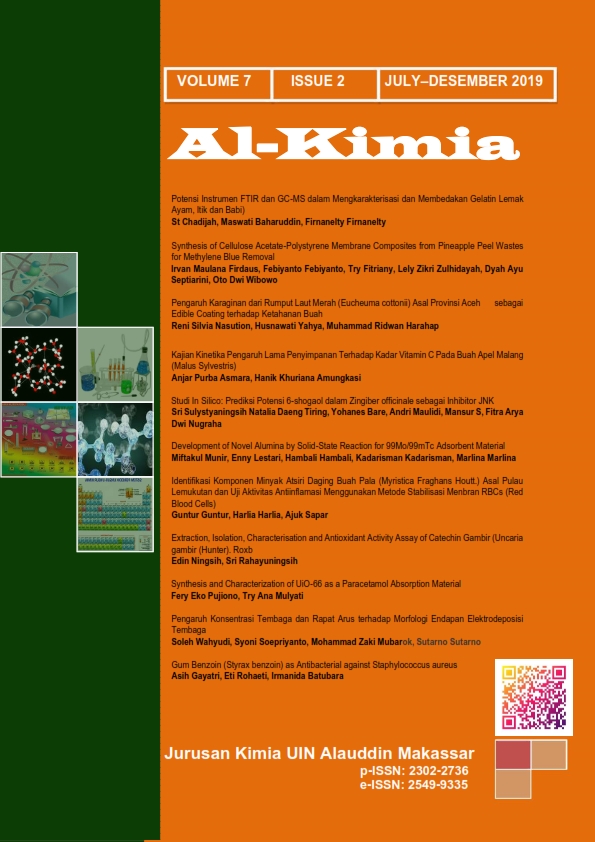Extraction, Isolation, Characterisation and Antioxidant Activity Assay of Catechin Gambir (Uncaria gambir (Hunter). Roxb
Abstract
Catechins are one of polyphenol compounds which reported have antioxidant properties. This study aims to extraction, isolation, characterization, and determine the antioxidant activity of catechin compounds from gambier powder(Uncaria gambir (Hunter). The extraction method used was maceration extraction with three types of solvents (70% ethanol, 70% methanol, and ethyl acetate). The process of purifying catechins is carried out with water, ethyl acetat, and n-hexane. Catechins were characterized by FTIR (Fourier Transform Infra Red) and UV-Vis spectrophotometer and tested for antioxidant activity using the DPPH (2.2 Difenyl -1-Pikrilhidrazil) method. The results showed that the extracted gambier using 70% ethanol solvent resulted in more catechins (51.20 g) than the 70% methanol solvent (40.35 g) and ethyl acetate (16.40 g). Characterization of catechin using UV-Vis spectrophotometer showed that purity content of catechins obtained from the extract ethanol 70% had purity 70.76%, methanol 70% 70.86%, and ethyl acetate 70.35%. Analysis using FTIR showed catechin has functional groups such as hydroxy (-OH), vibration C = C alkene, C-H, CH2 and C-O, so that the compound isolated has the basic structure of the catechin. The result of antioxidant activity from showed IC50 value are 2.72 ppm; 3.04 ppm and 3.06 ppm for extract catechin of etanol 70%, methanol 70% and ethyl acetate, so that can be said that catechins have antioxidant activity levels in a very strong category.
Downloads
References
Bhattacharjee, A., Shashidhara, S.C. & Saha, S. (2014) Isolation, Purification and Structural Elucidation of Bioactive Polyphenolic Compound (Catechin) From Crataeva Nurvala Buch- Ham Stem Bark Chloroform Fraction. [Online] 3 (2), 86–98. Available from: www.ijprbs.com.
Bondet, V., A, W.B.-W. & Berset, C. (1997) Kinetics and Mechanisms of Antioxidant Activity using the DPPH• Free Radical Method. [Online] 30 (6). Available from: doi:10.1006/fstl.1997.0240.
Ferdinand, A., Paradies, Y. & Kelaher, M. (2013) Mental Health Impacts of Racial Discrimination in Victorian Aboriginal Communities.
James, Z. et al. (2016) Solvent and Supercritical Fluid Extraction of Catechin from Camellia Sinensis (tea) Leaves for Utilization as Functional Food Ingredient. International Journal of Engineering and Technology IJET-IJENS. 16 (02), 21–33.
Kristina, N., Lestari, J. & Fauza, H. (2016) Keragaman morfologi dan kadar katekin tanaman gambir berdaun merah yang tersebar pada berbagai ketinggian tempat di Sumatera Barat. [Online] 2 (Fauza 2005), 43–48. Available from: doi:10.13057/psnmbi/m020109.
Mohammedi, Z. (2011) Impact of solvent extraction type on total polyphenols content and biological activity from Tamarix aphylla (L.) karst. International Journal of Pharma and Bio Sciences RESEARCH. 2 (1), 609–615.
Pérez-Jiménez, J. & Saura-Calixto, F. (2006) Effect of Solvent and Certain Food Constituents on Different Antioxidant Capacity Assays. Food Research International. [Online] 39 (7), 791–800. Available from: doi:10.1016/j.foodres.2006.02.003.
Pinelo, M. et al. (2005) Optimization of continuous phenol extraction from Vitis vinifera byproducts. Food Chemistry. 92 (1), Elsevier, 109–117.
Rahardiyan, D. (2019) Antibacterial potential of catechin of tea (Camellia sinensis) and its applications. Food Research. [Online] 3 (1), 1–6. Available from: doi:10.26656/fr.2017.3(1).097.
Rahman, H.A. (2016) Uji aktivitas antioksidan isolat katekin gambir (Uncaria gambier Roxb) pada tikus putih (Rattus norvegicus) jantan galur sprague dawley dengan diberi beban aktivitas fisik maksimal.
Rauf, R., Santoso, U. & Suparmo (2010) Aktivitas penangkapan radikal DPPH ekstrak gambir (Uncaria gambir Roxb.). Agritech. [Online] 30 (1), 1–3. Available from: doi:10.22146/agritech.9684.
Rohdiana, D. (2001) Aktivitas antiok!;idan teh selalu dihubungkan dengan adanya katekin. (1), 52–58.
Sultana, B., Anwar, F. & Ashraf, M. (2009) Effect of Extraction Solvent/Technique on the Antioxidant Activity of Selected Medicinal Plant Extracts. Molecules. [Online] 14 (6), 2167–2180. Available from: doi:10.3390/molecules14062167.
Vuong, Q. V. et al. (2010) Extraction and isolation of catechins from tea. Journal of Separation Science. [Online] 33 (21), 3415–3428. Available from: doi:10.1002/jssc.201000438.
Watanabe, M. (1998) Catechins as Antioxidants from Buckwheat ( Fagopyrum esculentum Moench) Groats. Journal of Agricultural and Food Chemistry. [Online] 46 (3), 839–845. Available from: doi:10.1021/jf9707546.
Widiyarti, G., Sundowo, A. & Angelina, M. (2014) Pembuatan Sediaan Oral Nutraceutical d ari Ekstrak Gambir ( Preparation of Oral Nutraceutical from Gambier Extract ). 12 (2), 145–153.
Widyasanti, A., Rohdiana, D. & Ekatama, N. (2016) Aktivitas antioksidan ekstrak teh putih (Camellia sinensis) dengan metode dpph (2, 2 difenil-1-pikrilhidrazil). Journal of Materials Processing Technology. 1 (1), 1–9.
Yeni, G. et al. (2017) Penentuan Teknologi Proses Pembuatan Gambir Murni dan Katekin Terstandar dari Gambir Asalan. Jurnal Litbang Industri. [Online] 7 (1), 1. Available from: doi:10.24960/jli.v7i1.2846.1-10.
Copyright (c) 2019 Edin Ningsih, Sri Rahayuningsih

This work is licensed under a Creative Commons Attribution-NonCommercial-ShareAlike 4.0 International License.
Authors who publish with this journal agree to the following terms:
1) Authors retain copyright and grant the journal right of first publication with the work simultaneously licensed under a Creative Commons Attribution License that allows others to share the work with an acknowledgement of the work's authorship and initial publication in this journal.
2) Authors are able to enter into separate, additional contractual arrangements for the non-exclusive distribution of the journal's published version of the work (e.g., post it to an institutional repository or publish it in a book), with an acknowledgement of its initial publication in this journal.
3)Authors are permitted and encouraged to post their work online (e.g., in institutional repositories or on their website) prior to and during the submission process, as it can lead to productive exchanges, as well as earlier and greater citation of published work (See The Effect of Open Access).


